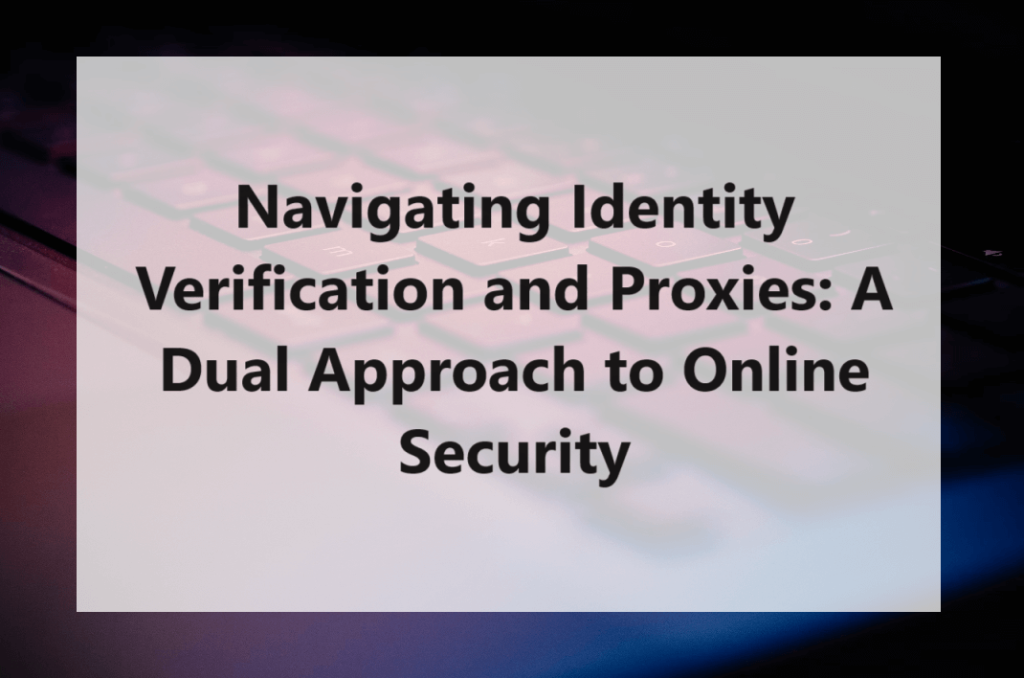Navigating Identity Verification and Proxies: A Dual Approach to Online Security

In the digital realm, the concepts of identity verification and the use of proxies often intersect, each playing a pivotal role in online security and privacy. While identification aims to ensure users are who they claim to be, proxies serve as intermediaries to enhance anonymity and security. This article explores how these two elements can be effectively balanced to create a secure and private online environment.
Understanding Identity Verification and Proxies
Identity verification
Identity verification is a process used to confirm a user’s identity, typically involving the validation of government-issued IDs or personal information. This process is crucial for:
- Preventing fraud: It helps mitigate identity theft, unauthorized access, and other fraudulent activities.
- Regulatory compliance: Many industries are mandated to perform identity checks to comply with laws like KYC and AML.
- Enhancing trust: Verified identities can increase user confidence in a platform, knowing that measures are in place to protect their data.
Proxies
A proxy server acts as a gateway between the user and the internet. It offers several benefits:
- Anonymity: Proxies can hide a user’s real IP address, making their online activities more anonymous.
- Security: They can act as a buffer, protecting against direct attacks on a user’s network.
- Content accessibility: Proxies enable users to bypass geographical restrictions and access a broader range of content.
The Interplay Between Identity Verification and Proxies
The relationship between identity verification and proxies is complex. On one hand, identification seeks transparency in user activities, while proxies often aim to mask these activities. Balancing these can be challenging but essential for maintaining security and privacy.
Learn more about the biggest cyber attacks in 2023!
Challenges in balancing both
- Privacy vs. Transparency: Users who value anonymity might find identity verification intrusive, while those who prioritize security may see proxies as a way to evade necessary checks.
- Technical complexity: Implementing both systems requires a nuanced understanding of network security and user privacy.
- Potential for misuse: Proxies can circumvent identification measures, posing a risk to platforms requiring strict user authentication.
Implementing Identity Verification with Proxy Awareness
Choosing the right tools
Selecting tools that can handle both identification and proxy detection is crucial. Look for solutions that offer a balanced approach, providing robust identity checks while respecting user privacy.
Educating users
Transparency about why identity verification is necessary and how proxies can be used responsibly is vital. Educating users on the importance of these measures can foster a more secure online environment.
Monitoring and adaptation
Regularly monitor the effectiveness of your identification and proxy detection systems. Be prepared to adapt these systems in response to emerging threats or changes in user behavior.
Privacy and legal considerations
Ensure that your identity verification and proxy usage approach complies with privacy laws and regulations. User consent and data protection should be top priorities.
Best Practices for Balancing Identity Verification and Proxy Use
- Layered security approach: Combine identification with other security measures like SSL certificates and firewalls.
- Regular updates: Keep your security systems updated to protect against new vulnerabilities.
- User-friendly verification processes: Implement verification processes that are secure yet user-friendly to ensure compliance without compromising user experience.
- Proxy management: Use advanced proxy detection tools to effectively identify and manage proxy traffic, distinguishing between legitimate and malicious use.
Conclusion
The dual implementation of identity verification and proxy awareness in online platforms presents a unique set of challenges and opportunities. Organizations can create a safe and trustworthy online environment by carefully balancing the need for security, transparency, and user privacy. The key lies in choosing the right tools, educating users, and continuously adapting to the evolving digital landscape. With these practices in place, the harmonious coexistence of identity verification and proxies can significantly enhance security and user experience in the digital domain.
